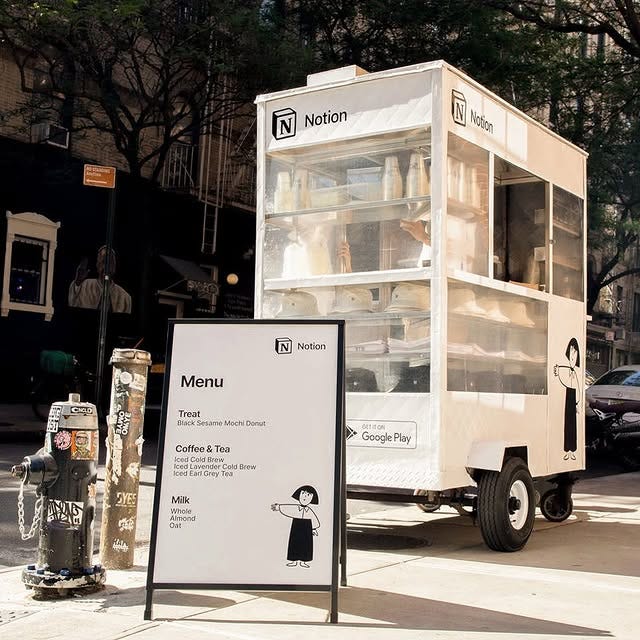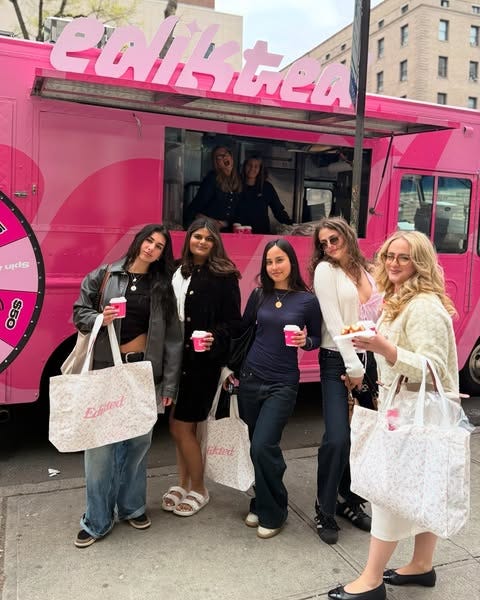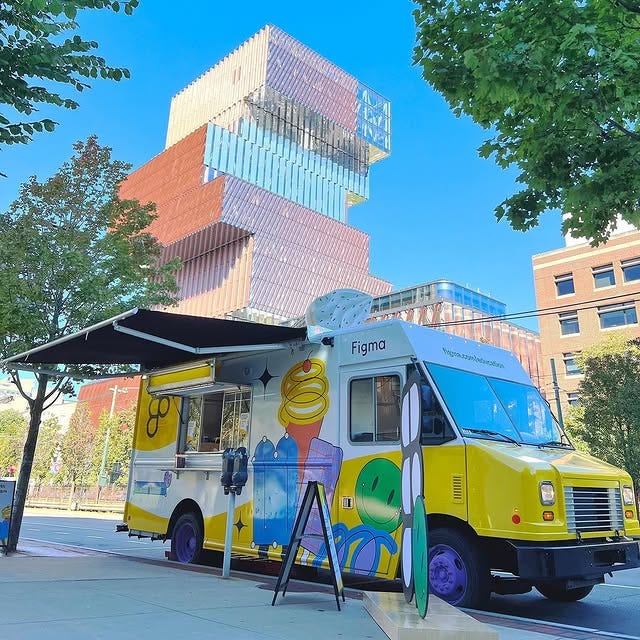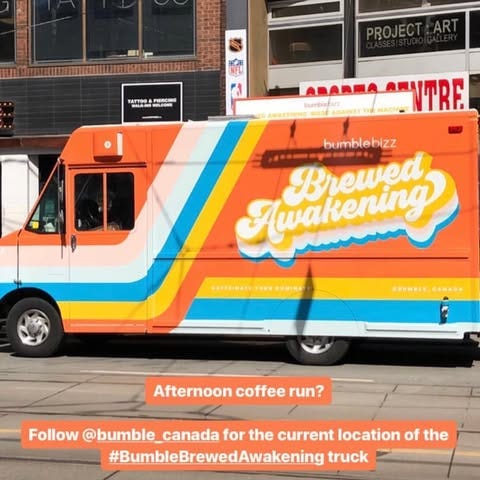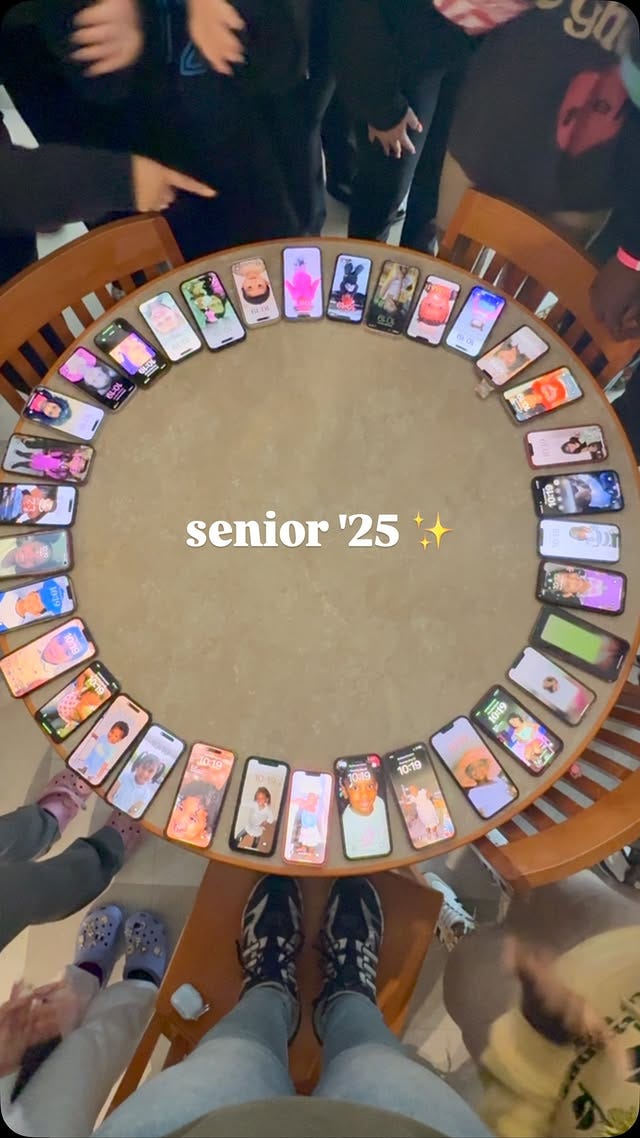On the web, this reed organ lives forever
Years after first creating Threnody for a Reed Organ, Jay Tobin put his endless generative music composition on a web page.
Today’s issue of PHONE TIME includes—a conversation with Jay Tobin about his generative music composition Threnody for a Reed Organ, and a roundup of internet news featuring The Guardian commenters’ thoughts on life pre-internet, graduation season as a content genre, and Addison Rae tarot cards.
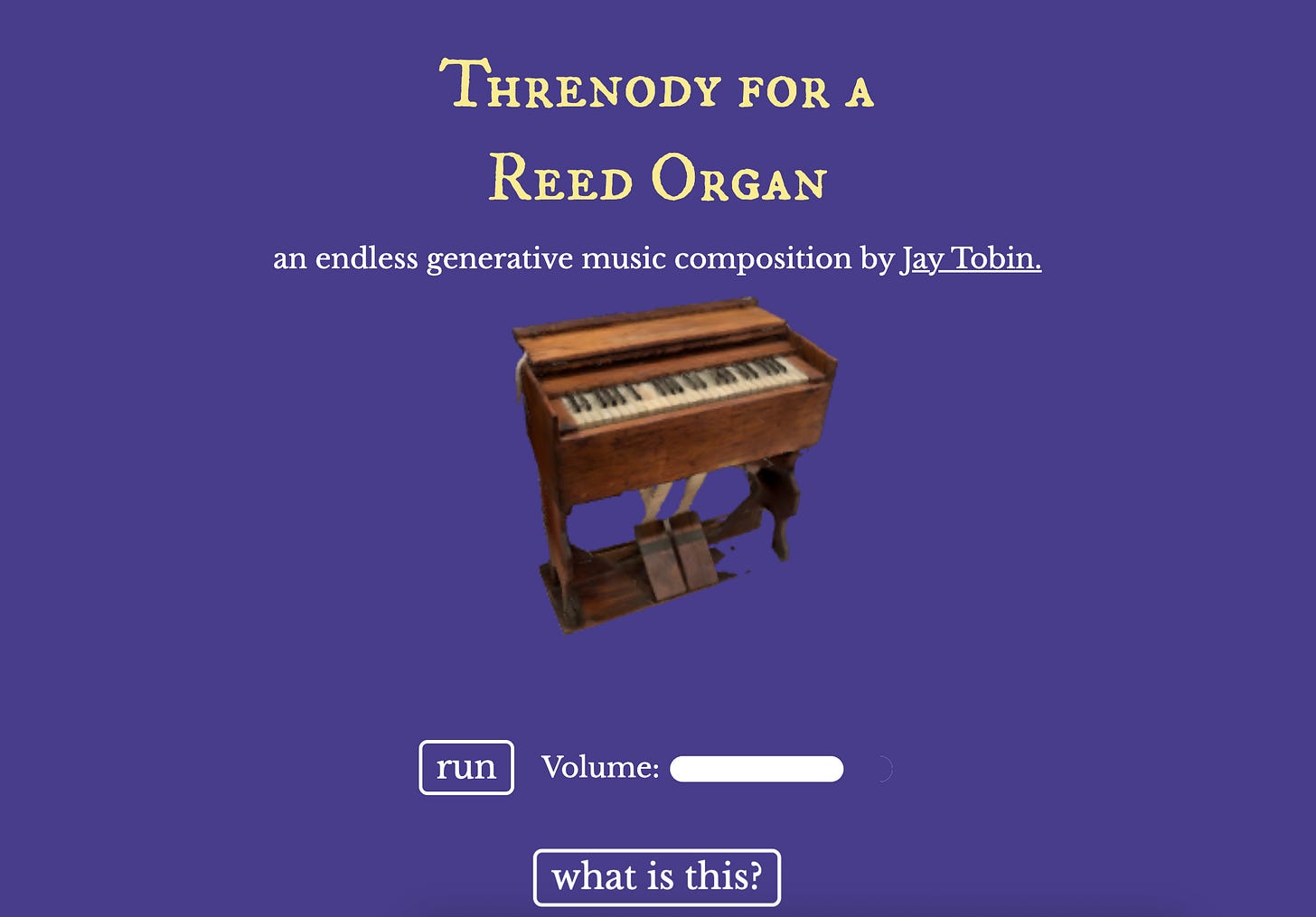
Last week, I spoke with web designer, developer, and sound artist Jay Tobin about his project Threnody for a Reed Organ, a generative music composition that plays endlessly on its web page, threnody.place. I know very little about reed organs, composing music, and even sound in general, but I found myself enthralled by the story of an old reed organ—a 1924 Estey Field reed organ, to be exact—that Tobin had discovered in a used organ warehouse in Stamford, Connecticut. It’s a story about preserving a piece of history, but also about how we can use the web to share creative things with other people.
“Threnody for a Reed Organ is something made to outlast the organ’s physical form: like a held memory, as long as this webpage exists, so too will the organ’s song,” the page reads.
This interview has been edited for length and clarity. You can click “run” on the Threnody web page and adjust the volume if you’d like to listen along while reading.
PHONE TIME: Can you start by giving me a bit of your background?
JAY TOBIN: I’ve been so many things at so many different times. These days, I usually introduce myself as a web developer/designer, but the only reason I got into it was for audio. I’m actually a sound artist slash generative composer slash tool builder. I love making weird little things that can just live on their own and do whatever they do—give them an input, and they kind of meander on, make their own sounds, and live their own lives.
I’ve been into music forever. My older brother was a jazz bassist who was really, really good. I could never figure out how to get really good at an instrument. So I discovered I could program my own things that sound good.
I think sometime in 2020, the people at Max/MSP [a visual programming language for music] came out with a thing called RNBO, and it lets you export things to the web. I was not interested in it at all. I was like, "This is terrible. I never want to touch the web.” Because I had tried to do web development before, and I was like “I can’t stand this.”
But I copied it and just kept messing around with it until I figured out what was happening, slowly but surely. I moved on with my life—just totally forgot about it for two years—and then came back to it after I decided I was going to do web dev to make money.
PHONE TIME: When did you first build Threnody for a Reed Organ?
TOBIN: I built Threnody for a class around 2017 or 2018 as a final project—just something to mess around with that seemed cool. It was way before I had even realized that I could use the web as a tool. The whole process behind it was that I had a really strong and unexplainable interest in wanting to go and buy a reed organ. Because I love reed organs, accordions, stuff like that.
“Threnody for a Reed Organ is something made to outlast the organ’s physical form: like a held memory, as long as this webpage exists, so too will the organ’s song; when the organ inevitably stops its song, Threnody will continue playing out endlessly, without chords repeating over themselves, a choral backing and guitar accents forever breathing life into its long, rattling drones.”
That led me to this really random used organ warehouse in Stamford, Connecticut. It was insane—wall-to-wall, old heritage organs, 200-year-old pianos. There was one there that was pretty much entirely broken. I sat down and played it and was like, “Oh, this is really incredible. This has an unbelievable sound.” It was going to be thrown out anyway, so I took it home for 50 bucks.
It’s technically transportable, but it weighs 80 pounds and is still incredibly cumbersome. We managed to get it into my parents’ house and into the basement. Every time I played it, it would start leaking more air and sound closer and closer to not working. I was like, “Wow, I really don’t want to lose this sound and the history behind this.”
I had an open-ended assignment for a class, so I decided to make a piece of generative software. I recorded a couple of chords off the organ and built a little system so that they loop into and play off of each other. The chords lead into other specific chords, and harmonies play with and lend themselves to each other. I threw a couple of extra little flourishes to keep it interesting. I put my voice on it, and then built it out.
It took me forever because I did not understand programming. I worked on it until the day it was due. It was a Max patch. Max is a music-making framework where you can do things like drop in filters or audio files. It’s very visual-forward, and gives you the option to hide things so that your patches don’t look horrifically ugly.
I just let it run in class for probably five minutes and was like, “All right, that’s enough.” And people were like, “No, keep it on, please. We want to hear the rest of it.” I was like, “Oh, it just keeps going.”

PHONE TIME: What happened with it after that class?
TOBIN: I had mentioned it probably wouldn’t see the light of day again. My professor was like, “You should probably not do that, and put this somewhere so that people can see it.”
I was trying to think of creative solutions. I left an old dinky laptop at my parents’ place, in my old room, that was just in the corner with the brightness all the way down, playing this thing and streaming it to Twitch for as long as it could. Because it was an old computer, it would sometimes just die or choose not to work. So I’d have to come up from New York City to my parents’ house, fix the computer, stay a couple of nights and then go back. Over and over again. I was like “This isn’t working. I feel like I’m wasting electricity.”
It languished for a long time, did nothing. I think I was looking through my files and found it: the old, unnamed random folders that were the bits and pieces making up the thing. I conveniently remembered that I had paid for a tool for Max/MSP’s converter from their software to web code, specifically for audio. I had used it once or twice. I was like, “I should just give it a shot.”
I made a couple of toy sequencer things, and I was like “Oh, this is cute.” And then I remembered that I had this entire system that I could just take from Max and put it online.
PHONE TIME: Tell me a bit more about why you wanted to put it on the web.
TOBIN: The piece is about wanting to make this organ live either forever or as long as it can, and it languishing in my backpack or on a shelf was not bad. But putting it on the web was like, as long as the domain’s active, this thing’s going to live. People can hear it. Especially now that the actual organ’s really breaking.
I was reading all kinds of stuff and getting really into web art at the time, like the work of Maya Man and Chia Amisola. I was like, “I really love this web art movement. This is fucking awesome. I really want to do something to contribute to this in some way, shape, or form. I already have a piece of music that could live on the web, so maybe this could be my contribution to the greater conversation of web as art, or DIY processes that result in art.”
I built it out and bought a domain. That was a whole process because everything was taken and the only one I could find was [.place]. I was like, “Cool, it’s done now. I never have to worry about it again. Whenever I want to hear it, I can just go to the website and fuck around with a little 3D scan that I made of the organ with my phone.”
I scanned the actual organ. You can see things like an engraving. One of the straps is totally broken. The left foot pedal never worked. It’s missing like three keys. It’s got three different finishes. So the visual side continues to tell the story of this one specific organ at this one specific moment captured in time.
PHONE TIME: What has the response been since putting it on the web?
TOBIN: It’s entirely different. The people I used to show it to were music nerds. The questions were, “How do you do that? What do you use? What software is this?” Which is fun—I’m also a music nerd, and I love answering those questions.
Now the questions are a lot more general and abstract. People on Instagram who visit my profile will find it and be like, “This thing’s really cool. What is this?” The questions and interactions are so much more fun now, because it’s so much easier to find. That was the whole point of trying to get in on the web. You don’t have to go into an art space to view it. You can take this thing with you and do whatever you want with it.
PHONE TIME: Are there other projects or ideas Threnody has inspired you to work on?
TOBIN: After owning a business for two years I was like, “Wow, I’ve done nothing but work on owning a business for two years.” And Threnody was the first thing I did in a while that felt artistically and soul-fulfilling. I was like “Shit, that was great. I need to do more of that, otherwise I’m going to lose myself in the small business owner, hypercapitalist loop.”
I have this tool that I built as part of my grad school thesis in 2022 called polyMorph, which was also just a big Max patch. It was cool and fun and it had interactive documentation, because I refuse to build or work on things that don’t make it really obvious how to use it. I don’t believe in exclusion.
Three weeks ago, I had this whole idea of a big, interactive web tool that takes up the full screen—to share it in a way that would empower people to make weird, strange music and use interfaces they would never have a chance to use unless they paid for them.
I’m waist-deep in figuring out how to build larger interactive systems for people to play live performances with. Trying to maybe build a community of folks around it so they can contribute. That’s the dream: to see if I can build something that other folks are like, “I want to add to this.”
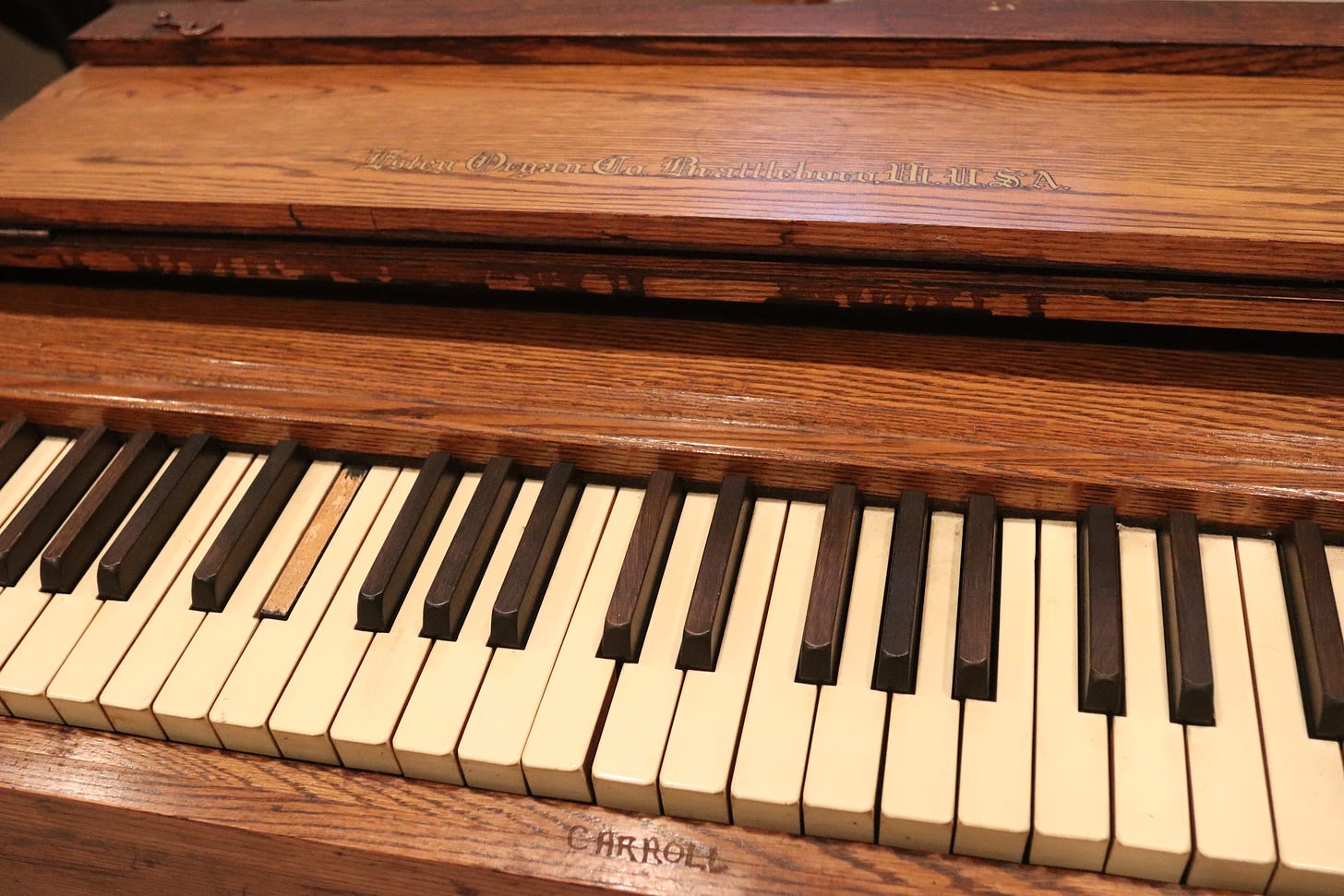
Elsewhere online
This piece by Isabel Brooks in The Guardian, titled “Why am I filled with nostalgia for a pre-internet age I never knew?”, touches on a theme I’ve been quite interested in lately. In my conversation with fragrance creator Lucy Sun, I noted that “even people who might have been a bit too young to be on the internet during [the 2000s] are still drawn to it. It feels so nostalgic and just like a better time to be online.” A lot of artists and technologists I speak with look to earlier eras of the web for inspiration. At the same time, doing archival research has taught me to interrogate feelings of nostalgia more critically—people were far from naive about the internet and social media’s potential harms, years and even decades ago.
There are 852 comments on the article. Some point out that the lede’s description that in 2003, “social media doesn’t exist yet,” isn’t exactly the full picture.
Here’s a few other highlights of what people had to say:
“Reading somebody speculating about the weird, unknowable experience that was my daily life seems very strange indeed, but your speculations are about right. Apart from pubs. We spent a lot of time in pubs. And not being photo'd or filmed all the time means we don't have to tell you the rest ;-)”
“Regarding authenticity, I grew up in the pre-internet age and people were just as eager to mindlessly chase the latest cool trend then as they are now. Before the internet it was magazines, music videos, tv shows, college radio, movies. Even then my friends and I would complain how mindless and phony everyone was…”
“VHS, Walkmans and CDs was peak tech for me after that I think it’s gone down hill.. Lol !”
“Looking at the comments,. and my own experience (as an oldie) I suspect it's not the Internet per se that is the problem, but that subset of it known as social media. Us oldies appreciate the Internet without being so caught up in SM, whereas younger generations seem to be so caught up in it that it is affecting their mental health.”
Perplexity is having a coffee truck—”Curiosity Café”—make stops around Manhattan during New York Tech Week. “Show your Perplexity mobile app for a cup of morning coffee and Enterprise Pro customers can pick up a bag of coffee beans on us,” reads the Partiful invite.
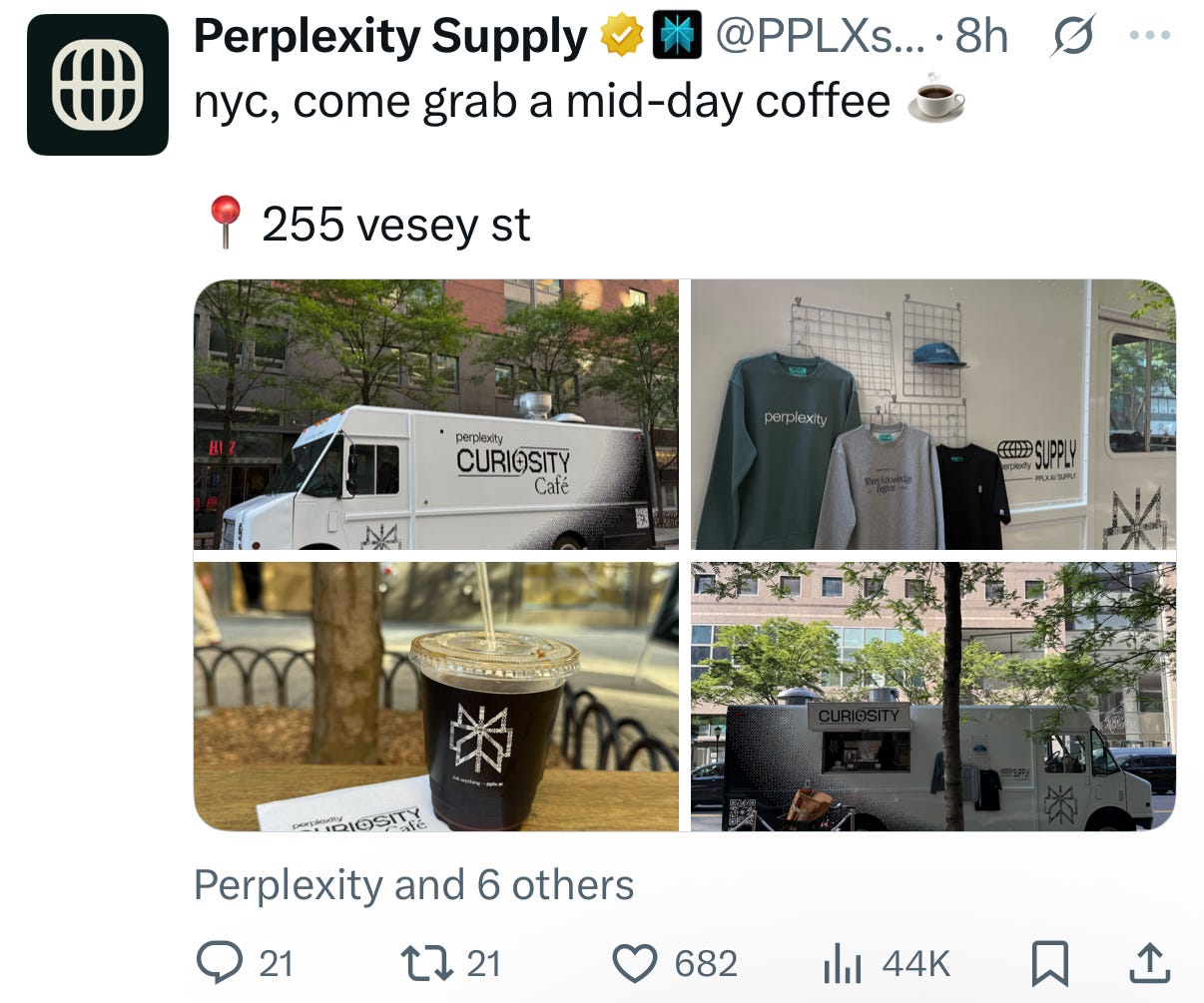
Perplexity Supply sells coffee beans that it describes as “a sensory journey that mirrors the path of inquiry.” Perplexity Supply @PPLXsupply . I’m quite interested in the coffee/ice cream/food truck marketing strategy. It’s something I saw a lot on my college campus, where students would quickly inform each other on Sidechat whenever a truck or pop-up appeared—college students especially love free food. The “show your downloaded app for a sweet treat” strategy is one I’d previously covered when I reported on the Bumble Honey college ambassador program back in 2022.
“Pinterest wooed GenZers. Will AI pins drive them away?”—Annabelle Choi, Fast Company.
Connecting your Spotify account will enable you to get a “personalized reading” of tarot cards on Addison Rae’s website.
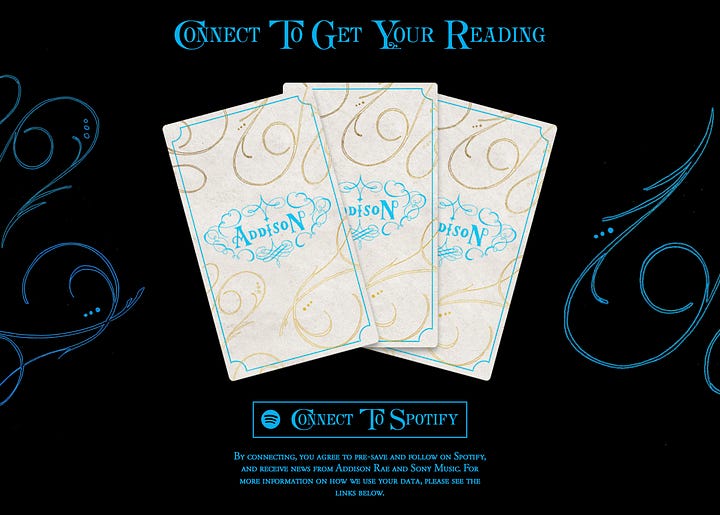

The cards display messages that align with songs on the upcoming album. Graduation season brings an entire genre of content with it. When I graduated high school in May 2020, online commemorations had become kind of a necessity. Students created Instagram yearbooks chronicling their post-graduation colleges, majors, and other plans—which have continued several years later. My high school’s newspaper actually stopped publishing its annual issue of students post-graduation plans citing, in part, students increasingly turning to a yearbook Instagram account.



